Home / Epoxides – The Outlier Of The Ether Family
Alcohols, Epoxides and Ethers
Epoxides – The Outlier Of The Ether Family
Last updated: June 5th, 2025 |
Properties and Synthesis of Epoxides
- Epoxides (oxiranes) are cyclic ethers that have unusually high reactivity due to ring strain (about 25 kcal/mol).
- The 3-membered ring of epoxides can be opened under both acidic and basic conditions.
- Epoxides can be synthesized from alkenes via epoxidation with a peroxyacid like m-CPBA, or from halohydrins via treatment with base.
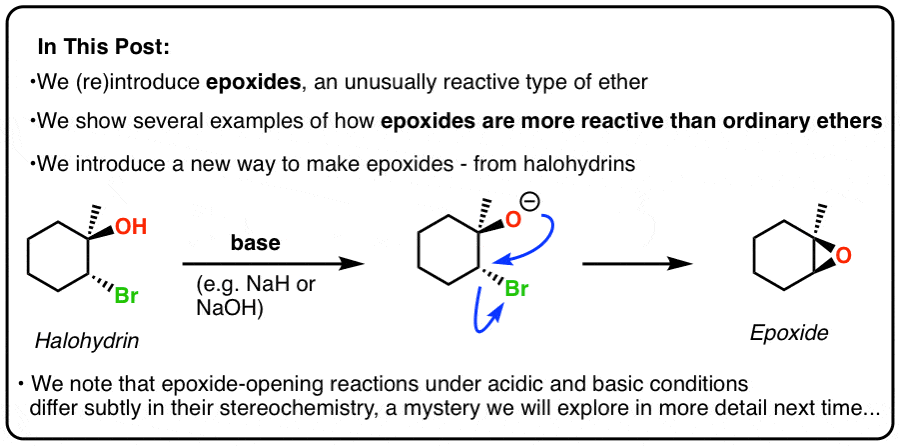
Table of Contents
- Cleavage of Ethers Generally Requires Very Harsh Conditions
- Epoxides (“Oxiranes”) Are An Unusually Reactive Type of Cyclic Ether
- Epoxides React With Aqueous Acid Under Mild Conditions To Form Diols
- Unlike Most Ethers, Epoxides Can Be Easily Cleaved With Aqueous Base
- Synthesis of Epoxides (1): Reaction of Alkenes With A Peroxyacid
- Synthesis of Epoxides (2): Treating Halohydrins With Base
- Opening Of Epoxides Gives Different Products Depending On Whether Acid Or Base Is Used
- Notes
- Quiz Yourself!
- (Advanced) References and Further Reading
1. Cleavage of Ethers Generally Requires Very Harsh Conditions
In the last post, I wrote that ethers were quite possibly the most boring functional group of all, at least from the perspective of reactivity. This got some friendly flak from an inorganic chemist in the crowd, but for our purposes, it’s true. We only cover one reaction: how to cleave ethers with strong acid.
To review, here’s what this reaction looks like for several different ethers. Since an “ether” is a functional group with an oxygen connected to two carbons, this also includes cyclic cases such as the five membered and three membered cyclic ethers below.
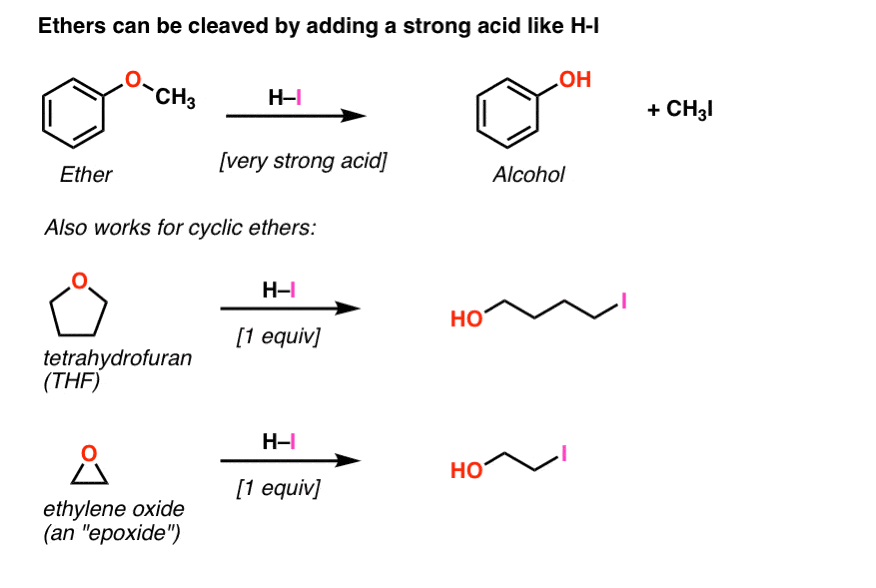
In this reaction, we protonate the ether oxygen with strong acid [making a good leaving group] and one of the adjacent carbons is then attacked by a nucleophile [I- in this case] leading to the rupture of the C-O bond and formation of the alcohol and alkyl iodide shown above.
Opening up a cyclic molecule is akin to taking off a belt: by opening up the “buckle” [i.e. breaking the C-O bond] we go from a “loop” back to a “strip”. It is the same with cyclic molecules – see how the second and third examples open to give linear products.
By the way, that first example is the answer to the quiz at the bottom of the last post. The second example shows the cyclic ether tetrahydrofuran (THF), which you’ve probably seen in other contexts – as an organic solvent, for instance. The third example shows a class of molecules you’ve likely seen before but might not have thought of as an ether – the three-membered cyclic ethers we call “epoxides” [or sometimes, “oxiranes“].
2. Epoxides (“Oxiranes”) Are An Unusually Reactive Type of Cyclic Ether
If you think of ethers as a generally staid, stable, and placid family of functional groups, epoxides are definitely the outlier.

What makes epoxides so unusual – and interesting?
The interior bond angles of epoxides are about 60°. Contrast that with the “ideal” bond angle of 109.5° for tetrahedral carbon, and you’ll appreciate that like cyclopropane discussed earlier, they possess considerable ring strain.
This ring strain – about 25 kcal/mol [Ref]- has the effect of making them”spring-loaded” if you will, toward opening.
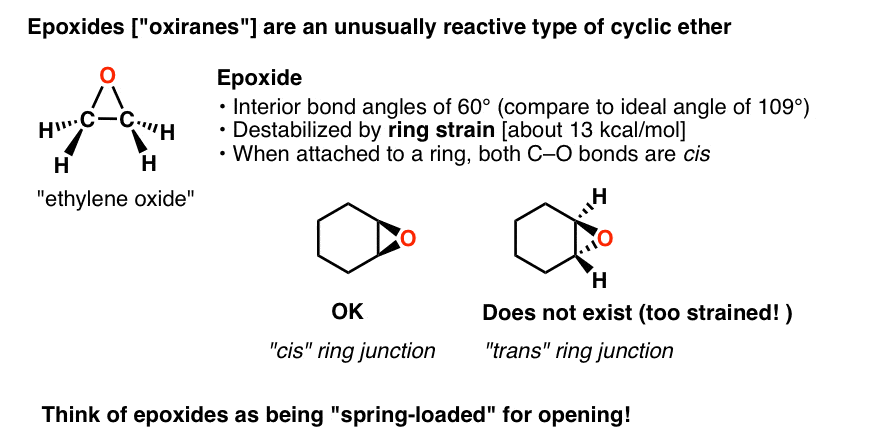
[It’s important to keep one thing in mind when drawing epoxides, especially with respect to their position on rings. The two C-O bonds must always be on the same “face” of the ring [i.e. making a “cis” ring junction]. The “trans” ring junction version is too strained to exist]
Let’s look at some examples of how epoxides are more reactive than “regular” ethers.
3. Epoxides React With Aqueous Acid Under Mild Conditions To Form Diols
First of all, they react with acid under much milder conditions than, say, diethyl ether. For example, treating an epoxide with aqueous acid [H3O+] will open an epoxide to provide a 1,2-diol [often called a “vicinal diol” or a “glycol”]. Under the same conditions that open the epoxide, diethyl ether is inert [as are most ethers].

[We’ll explore this reaction of epoxides in more detail in subsequent posts].
4. Unlike Most Ethers, Epoxides Can Be Easily Cleaved With Aqueous Base
Secondly: unlike the vast majority of ethers, epoxides can also be cleaved with base. For example, treatment of an epoxide such as ethylene oxide with sodium hydroxide in water similarly leads to formation of a vicinal diol [this is “ethylene glycol“, by the way, a common component of antifreeze].
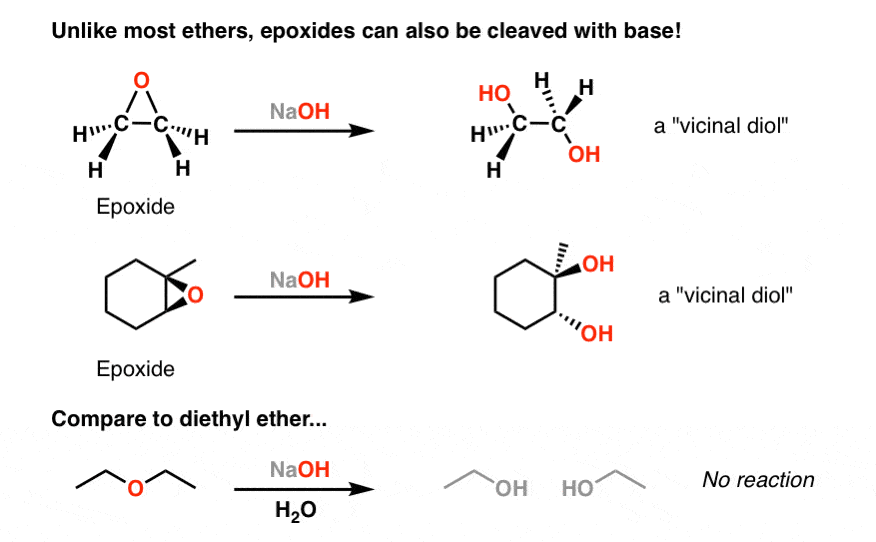
Other nucleophiles besides hydroxide ion can be used to open ethers (see post: Opening of Epoxides With Base)
The key point to absorb here is that epoxides are not typical ethers, and thus deserve their own discussion.
Let’s back up a bit.
5. Synthesis of Epoxides (1): Reaction of Alkenes With A Peroxyacid
I mentioned that you’d likely seen epoxides before, likely when you covered the reaction of alkenes. There’s two important ways to make epoxides from alkenes, one “direct” and one “indirect”. Let’s review the first method.
Treating an alkene with a “peroxyacid” (that’s a carboxylic acid containing an extra oxygen) leads to direct formation of an epoxide. A popular peroxyacid for this purpose is m-CPBA [m-chloroperoxybenzoic acid], although other peroxyacids of the general form RCO3H also find use. We talked about this reaction in more detail here. (See post: Reactions of Alkenes – the Concerted Pathway)
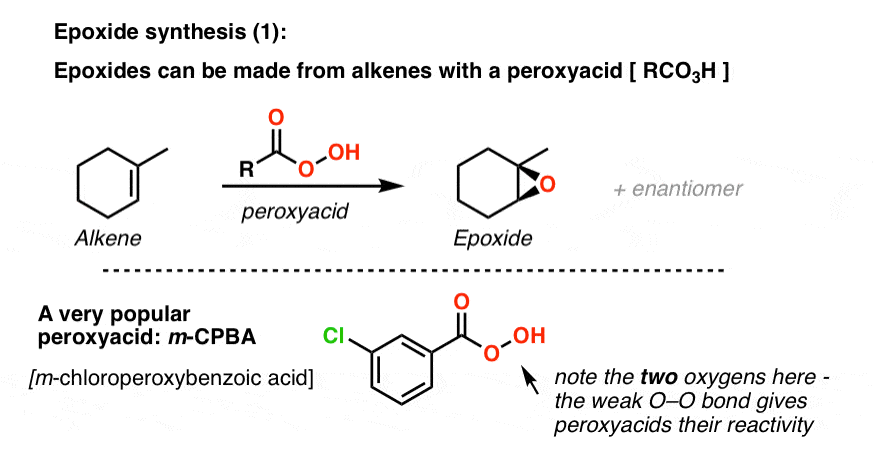
6. Synthesis of Epoxides (2): Treating Halohydrins With Base
There’s a second way to make epoxides via a two-step process that I don’t believe we’ve covered here before. Starting with an alkene, if one adds a halogen (such as Br2 or Cl2) and water as solvent, we make a species known as a halohydrin. Treatment of a halohydrin with strong base (such as NaH or NaOH) leads to deprotonation of the OH to give O- , which then displaces the adjacent halide via SN2 reaction to provide the resulting epoxide. [why deprotonation and not SN2? see Note 1]

Note that stereochemistry is important here! SN2 reactions proceed via a backside attack, (See post: The SN2 Mechanism) leading to inversion of configuration. If the halohydrin is “locked” in position (as part of a ring, for example) and the alkoxide [O- ] cannot approach the backside of the C-Br bond, then the SN2 cannot occur and therefore an epoxide will not be formed. Instructors love to ask questions like this, so be alert!
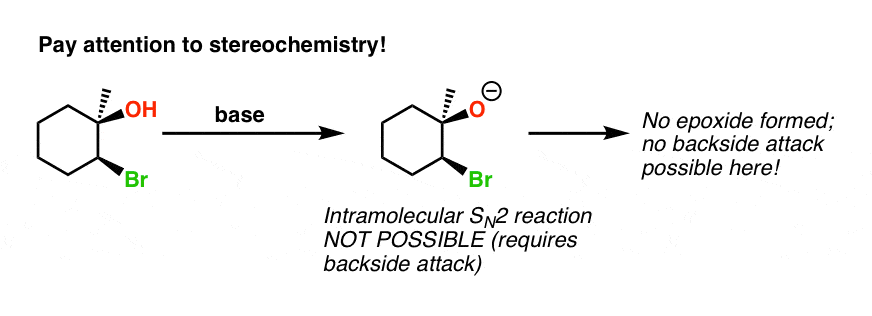
7. Opening Of Epoxides Gives Different Products Depending On Whether Acid Or Base Is Used
This post has given us a little taste of the properties, reactions, and synthesis of epoxides, but there are many more details to explore here. For example, if you are very observant, you might have noticed an odd thing about the reactions of that cyclohexane epoxide from the acid and base slides: it gives a different product depending on whether H3O+ or NaOH is added!
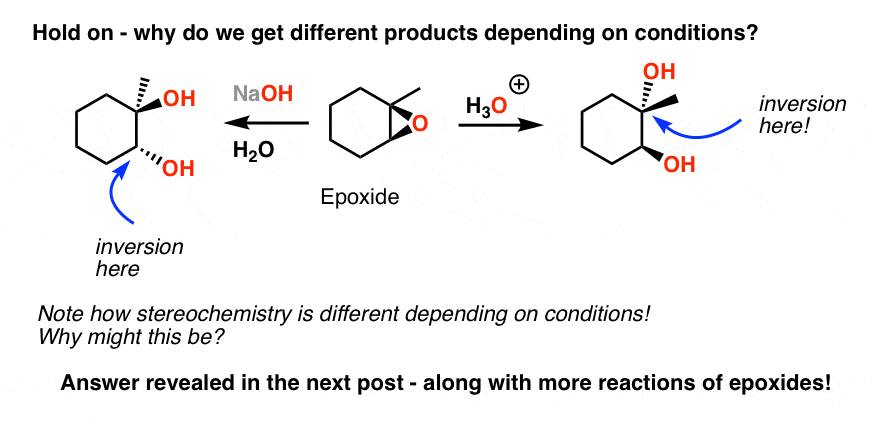
This isn’t a typo! This represents the actual pattern of reactivity of this epoxide. Isn’t it strange that NaOH and H3O+ should lead to different products. Why might that be?
One hint: this is a consequence of the fact that these reactions go through different mechanisms. Mechanisms that – believe it or not – we have seen before, in one form or another. However, this dichotomy of mechanism is a prime source of confusion for students on this topic, and again, one that tends to be heavily tested on exams.
We’ll start to delve into this mystery in the next post – as well as explore the reactions of epoxides in greater detail.
Next Post – Opening Of Epoxides With Acid
Notes
Related Articles
- Opening of Epoxides With Acid
- Reagent Friday: m-CPBA (meta-chloroperoxybenzoic acid)
- Formation of epoxides from bromohydrins (MOC Reaction Guide)
- Cleavage Of Ethers With Acid
- Epoxide Ring Opening With Base
- Reaction of epoxides with nucleophiles under basic conditions (MOC Membership)
- The SN2 Mechanism
- Acid Base Reactions Are Fast
Note 1. By the way: you might ask – why doesn’t NaOH just do a backside attack on the C-Br bond in the first example? The answer is that acid-base reactions tend to be fast relative to substitution reactions, because there is very little atomic reorganization required. Secondly, once the alcohol has been deprotonated, the intramolecular SN2 reaction [forming the epoxide] is faster than the intermolecular SN2 forming a new alcohol, because the proximity of the O- to the C-Br gives it a higher “effective concentration”. ]
Note 2. Some bond dissociation energies of C-O bonds in cyclic ethers
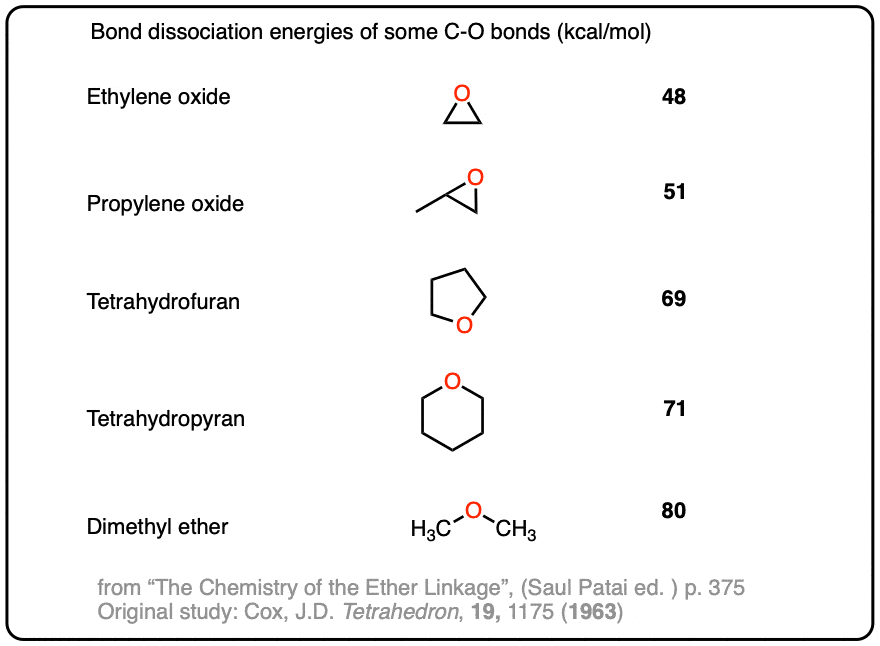
Quiz Yourself!
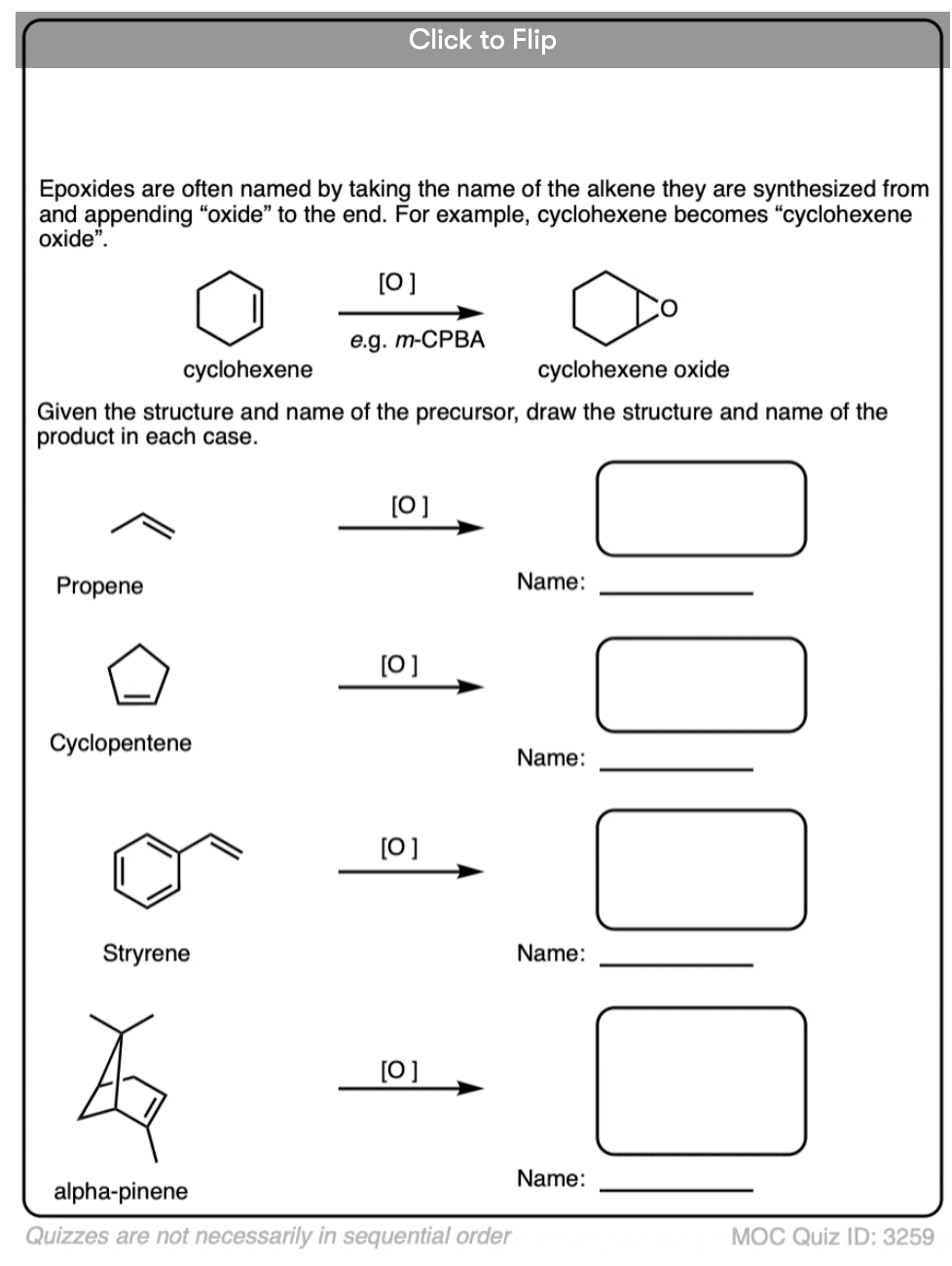
Become a MOC member to see the clickable quiz with answers on the back.
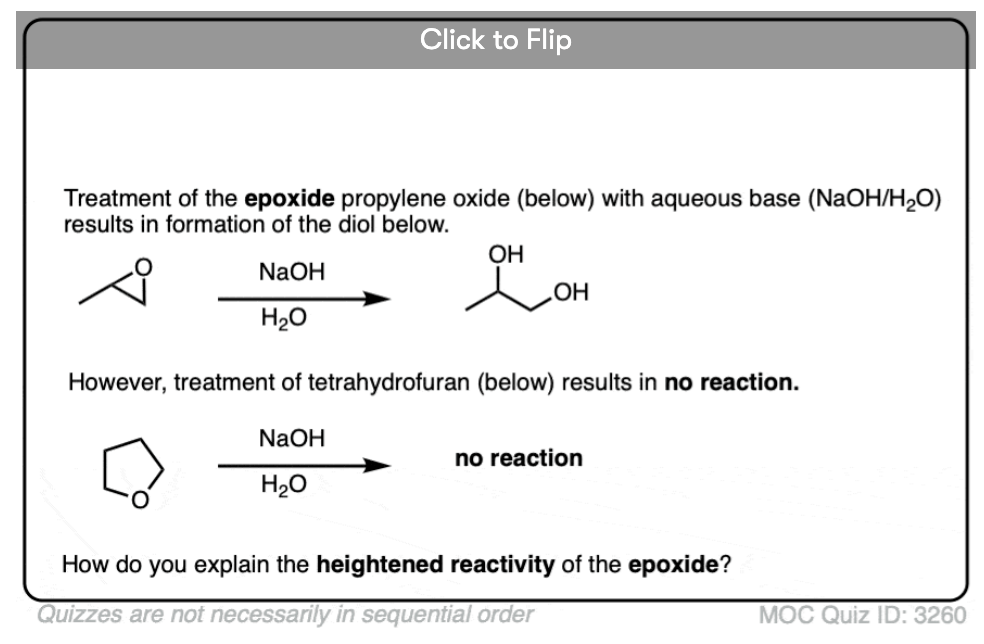
Become a MOC member to see the clickable quiz with answers on the back.

Become a MOC member to see the clickable quiz with answers on the back.
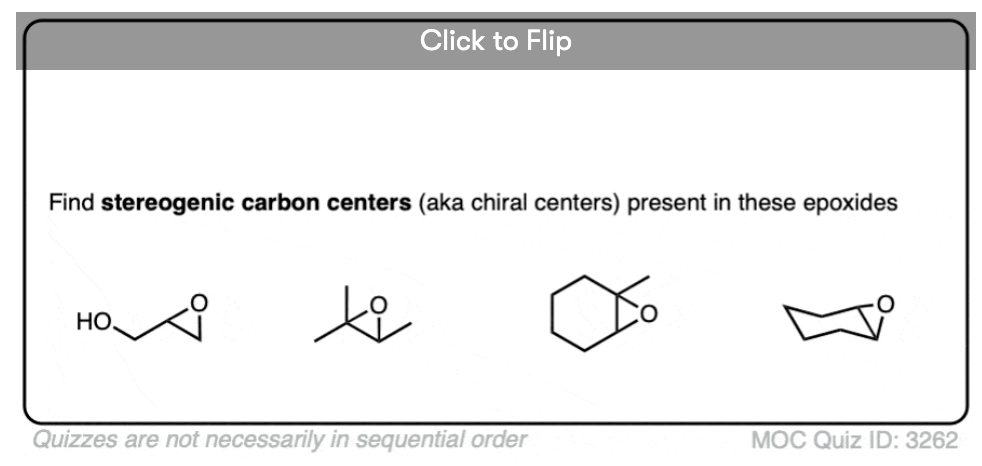
Become a MOC member to see the clickable quiz with answers on the back.

Become a MOC member to see the clickable quiz with answers on the back.
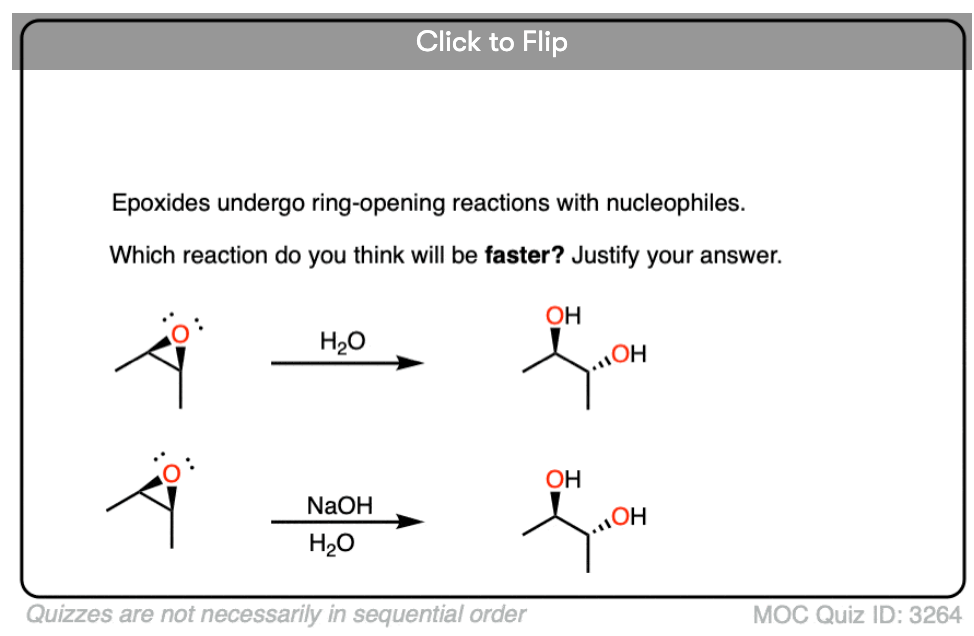
Become a MOC member to see the clickable quiz with answers on the back.
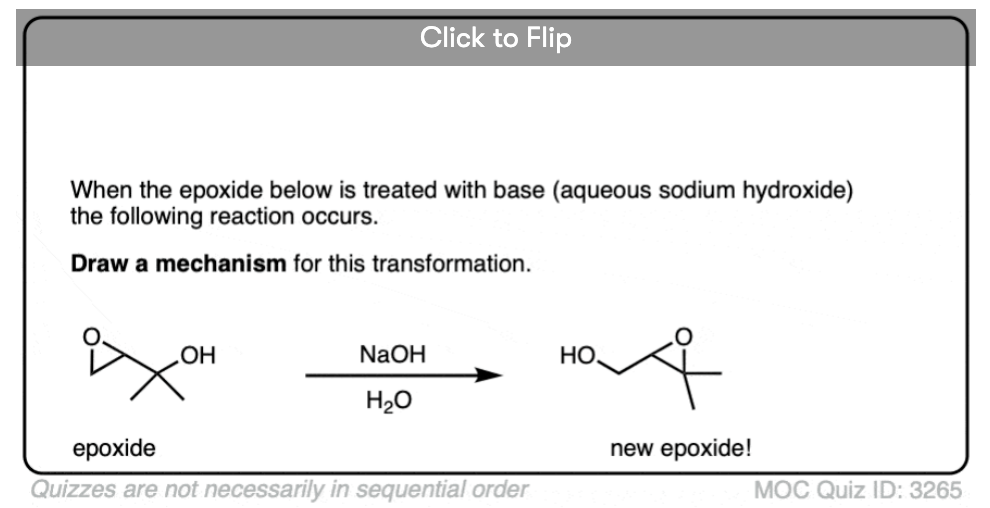
Become a MOC member to see the clickable quiz with answers on the back.
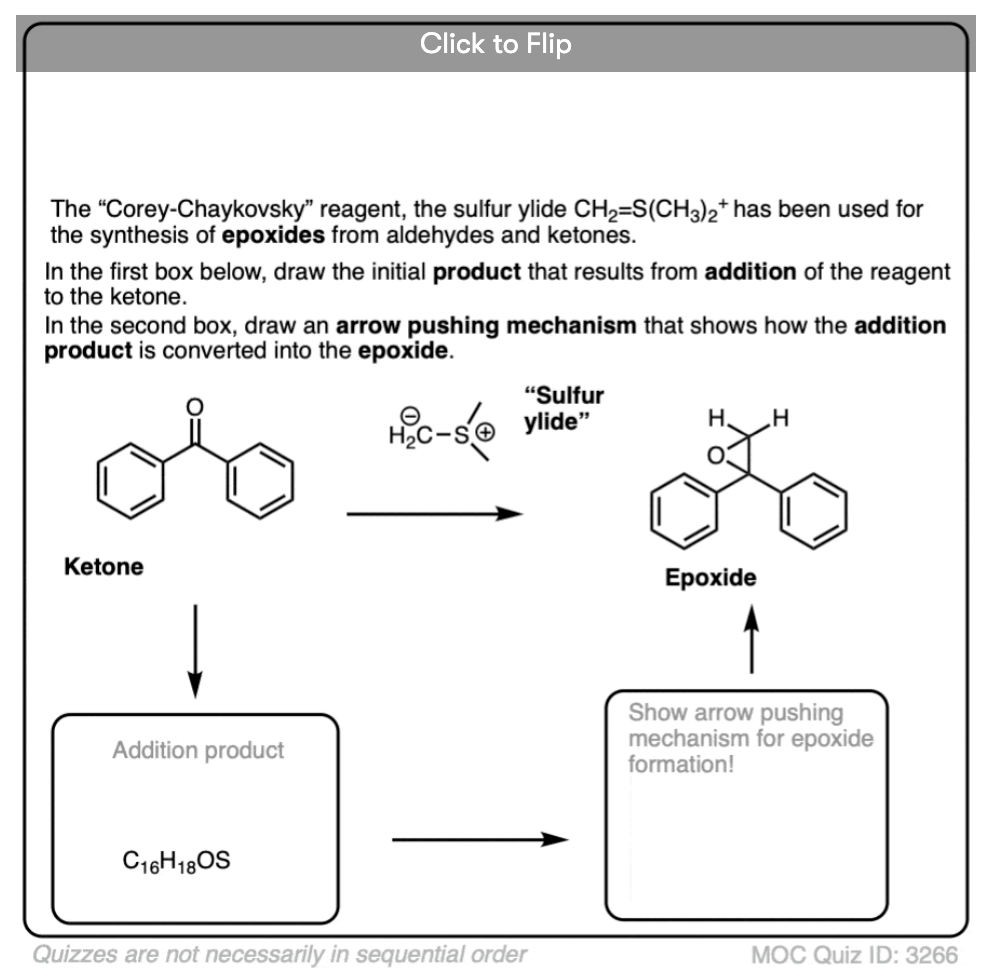
Become a MOC member to see the clickable quiz with answers on the back.
(Advanced) References and Further Reading
Epoxide formation from halohydrins:
This reaction can be considered as an internal Williamson Ether Synthesis.
- CYCLOHEXENE OXIDE
A. E. Osterberg
Org. Synth. 1925, 5, 35
DOI: 10.15227/orgsyn.005.0035
Simple, straightforward Organic Syntheses prep of cyclohexene oxide from the chlorohydrin. - Kinetics of formation of substituted styrene oxides by reaction of 2-aryl- and 1-aryl-2-halogenoethanols with aqueous alkali
Anthony C. Knipe
J. Chem. Soc. Perkin Trans. 2 1973, 589-595
DOI: 10.1039/P29730000589
This paper studies the kinetics of styrene oxide formation using a Hammett plot, a classic tool of physical organic chemistry. - Stereochemical Aspects of the Synthesis of 1,2‐Epoxides
Giancarlo Berti
Topics in Stereochemistry 1973, 93
DOI:1002/9780470147160.ch2
See page 187 in this review for a detailed discussion of the formation of epoxides from halohydrins. - Neighboring group effects in the regioselective cyclization of vicinal trans-1,2-bromohydrins to epoxides
Fengrui Lang, Darren J. Kassab, Bruce Ganem
Tetrahedron Lett. 1998, 39 (33), 5903-5906
DOI: 10.1016/S0040-4039(98)01243-X
The course of this intramolecular epoxide formation can also be influenced by neighboring group effects. - Diastereo- and enantioselective synthesis of α,β-epoxyketones using aqueous NaOCl in conjunction with dihydrocinchonidine derived phase-transfer catalysis at room temperature. Scope and limitations
Barry Lygo, Stuart D. Gardiner, Michael C. McLeod, and Daniel C. M. To
Org. Biomol. Chem. 2007, 5, 2283-2290
DOI: 10.1039/B706546A
Enantioselective epoxide-forming reactions are known, using chiral additives (e.g. dihydrocinchonidines).Epoxidation of alkenes with m-CPBA: - Oxydation ungesättigter Verbindungen mittels organischer Superoxyde
Nikolaus Prileschajew
Chemische Berichte 1909 42, 4811
DOI: 10.1002/cber.190904204100
This reaction (epoxidations of alkenes with a peracid) is also known as the Prizelhaev reaction after the author. - The oxidation of olefins with perbenzoic acids. A kinetic study
B. M. Lynch and K. H. Pausacker
J. Chem. Soc., 1955, 1525-1531
DOI: 10.1039/JR9550001525
One of the earliest papers on epoxidation with m-CPBA, comparing its reactivity with other substituted peracids. As expected, the reactivity of peroxyacids is increased by electron-withdrawing groups. - m-CHLOROPERBENZOIC ACID
Richard N. McDonald, Richard N. Steppel, and James E. Dorsey
Org Synth. Vol. 50, p.15 (1970)
DOI: 10.15227/orgsyn.050.0015
A reliable preparation for m-CPBA (which is commercially available) in Organic Syntheses. As this procedure shows, m-CPBA is not prepared as a pure compound (it is a mixture of the peracid and acid, and commercial samples may contain residual water for stability). - Epoxidations with m-Chloroperbenzoic Acid
Nelson N. Schwartz and John H. Blumbergs
The Journal of Organic Chemistry 1964 29 (7), 1976-1979
DOI: 1021/jo01030a078
This paper describes mechanistic studies of m-CPBA oxidation that demonstrate that ionic intermediates are not involved in the reaction, and that the rate is insensitive to solvent polarity. - Bartlett, P. D.
Rec. Chem. Prog. 1950, 11, 47
This is the publication in which Prof. P. D. Bartlett describes the ‘butterfly mechanism’ for m-CPBA epoxidation. - MCPBA Epoxidation of Alkenes: Reinvestigation of Correlation between Rate and Ionization Potential
Cheal Kim, Teddy G. Traylor, and Charles L. Perrin
Journal of the American Chemical Society 1998 120 (37), 9513-9516
DOI:1021/ja981531e
An interesting paper that describes the development of a kinetic method for measuring the rate of epoxidation of various alkenes with m-CPBA. - Experimental Geometry of the Epoxidation Transition State
Daniel A. Singleton, Steven R. Merrigan, Jian Liu, and K. N. Houk
Journal of the American Chemical Society 1997 119 (14), 3385-3386
DOI:1021/ja963656u
Combined experimental and theoretical studies of the epoxidation transition state, showing that both C-O bond forming events are nearly synchronous. - The mechanism of epoxidation of olefins by peracids
V. G. Dryuk
Tetrahedron Volume 32, Issue 23, 1976, Pages 2855-2866
DOI: 10.1016/0040-4020(76)80137-8
An account of the author’s work on kinetic studies of the epoxidation of olefins with peracids in order to determine the exact mechanism. - Thermochemical Studies of Epoxides and Related Compounds
Kathleen M. Morgan, Jamie A. Ellis, Joseph Lee, Ashley Fulton, Shavonda L. Wilson, Patrick S. Dupart, and Rosanna Dastoori
The Journal of Organic Chemistry 2013, 78 (9), 4303-4311
DOI: 1021/jo4002867
Table 7 in this paper contains strain energies of cyclopropane, epoxides, aziridines, thiiranes, and the phosphorous analog (which is purely theoretical). Table 8 contains strain energies of epoxides. These values are obtained through computational methods, and are compared with experimentally derived values where possible. Oxirane has a strain energy of 27.3 kcal/mol, which is reduced with alkyl substitution.
Note – an earlier version of this article quoted a ring strain for epoxides of about 13 kcal/mol. This is in error.
00 General Chemistry Review
01 Bonding, Structure, and Resonance
- How Do We Know Methane (CH4) Is Tetrahedral?
- Hybrid Orbitals and Hybridization
- How To Determine Hybridization: A Shortcut
- Orbital Hybridization And Bond Strengths
- Sigma bonds come in six varieties: Pi bonds come in one
- A Key Skill: How to Calculate Formal Charge
- The Four Intermolecular Forces and How They Affect Boiling Points
- 3 Trends That Affect Boiling Points
- How To Use Electronegativity To Determine Electron Density (and why NOT to trust formal charge)
- Introduction to Resonance
- How To Use Curved Arrows To Interchange Resonance Forms
- Evaluating Resonance Forms (1) - The Rule of Least Charges
- How To Find The Best Resonance Structure By Applying Electronegativity
- Evaluating Resonance Structures With Negative Charges
- Evaluating Resonance Structures With Positive Charge
- Exploring Resonance: Pi-Donation
- Exploring Resonance: Pi-acceptors
- In Summary: Evaluating Resonance Structures
- Drawing Resonance Structures: 3 Common Mistakes To Avoid
- How to apply electronegativity and resonance to understand reactivity
- Bond Hybridization Practice
- Structure and Bonding Practice Quizzes
- Resonance Structures Practice
02 Acid Base Reactions
- Introduction to Acid-Base Reactions
- Acid Base Reactions In Organic Chemistry
- The Stronger The Acid, The Weaker The Conjugate Base
- Walkthrough of Acid-Base Reactions (3) - Acidity Trends
- Five Key Factors That Influence Acidity
- Acid-Base Reactions: Introducing Ka and pKa
- How to Use a pKa Table
- The pKa Table Is Your Friend
- A Handy Rule of Thumb for Acid-Base Reactions
- Acid Base Reactions Are Fast
- pKa Values Span 60 Orders Of Magnitude
- How Protonation and Deprotonation Affect Reactivity
- Acid Base Practice Problems
03 Alkanes and Nomenclature
- Meet the (Most Important) Functional Groups
- Condensed Formulas: Deciphering What the Brackets Mean
- Hidden Hydrogens, Hidden Lone Pairs, Hidden Counterions
- Don't Be Futyl, Learn The Butyls
- Primary, Secondary, Tertiary, Quaternary In Organic Chemistry
- Branching, and Its Affect On Melting and Boiling Points
- The Many, Many Ways of Drawing Butane
- Wedge And Dash Convention For Tetrahedral Carbon
- Common Mistakes in Organic Chemistry: Pentavalent Carbon
- Table of Functional Group Priorities for Nomenclature
- Summary Sheet - Alkane Nomenclature
- Organic Chemistry IUPAC Nomenclature Demystified With A Simple Puzzle Piece Approach
- Boiling Point Quizzes
- Organic Chemistry Nomenclature Quizzes
04 Conformations and Cycloalkanes
- Staggered vs Eclipsed Conformations of Ethane
- Conformational Isomers of Propane
- Newman Projection of Butane (and Gauche Conformation)
- Introduction to Cycloalkanes
- Geometric Isomers In Small Rings: Cis And Trans Cycloalkanes
- Calculation of Ring Strain In Cycloalkanes
- Cycloalkanes - Ring Strain In Cyclopropane And Cyclobutane
- Cyclohexane Conformations
- Cyclohexane Chair Conformation: An Aerial Tour
- How To Draw The Cyclohexane Chair Conformation
- The Cyclohexane Chair Flip
- The Cyclohexane Chair Flip - Energy Diagram
- Substituted Cyclohexanes - Axial vs Equatorial
- Ranking The Bulkiness Of Substituents On Cyclohexanes: "A-Values"
- Cyclohexane Chair Conformation Stability: Which One Is Lower Energy?
- Fused Rings - Cis-Decalin and Trans-Decalin
- Naming Bicyclic Compounds - Fused, Bridged, and Spiro
- Bredt's Rule (And Summary of Cycloalkanes)
- Newman Projection Practice
- Cycloalkanes Practice Problems
05 A Primer On Organic Reactions
- The Most Important Question To Ask When Learning a New Reaction
- Curved Arrows (for reactions)
- Nucleophiles and Electrophiles
- The Three Classes of Nucleophiles
- Nucleophilicity vs. Basicity
- What Makes A Good Nucleophile?
- What Makes A Good Leaving Group?
- 3 Factors That Stabilize Carbocations
- Equilibrium and Energy Relationships
- 7 Factors that stabilize negative charge in organic chemistry
- 7 Factors That Stabilize Positive Charge in Organic Chemistry
- What's a Transition State?
- Hammond's Postulate
- Learning Organic Chemistry Reactions: A Checklist (PDF)
- Introduction to Oxidative Cleavage Reactions
06 Free Radical Reactions
- Bond Dissociation Energies = Homolytic Cleavage
- Free Radical Reactions
- 3 Factors That Stabilize Free Radicals
- What Factors Destabilize Free Radicals?
- Bond Strengths And Radical Stability
- Free Radical Initiation: Why Is "Light" Or "Heat" Required?
- Initiation, Propagation, Termination
- Monochlorination Products Of Propane, Pentane, And Other Alkanes
- Selectivity In Free Radical Reactions
- Selectivity in Free Radical Reactions: Bromination vs. Chlorination
- Halogenation At Tiffany's
- Allylic Bromination
- Bonus Topic: Allylic Rearrangements
- In Summary: Free Radicals
- Synthesis (2) - Reactions of Alkanes
- Free Radicals Practice Quizzes
07 Stereochemistry and Chirality
- Types of Isomers: Constitutional Isomers, Stereoisomers, Enantiomers, and Diastereomers
- How To Draw The Enantiomer Of A Chiral Molecule
- How To Draw A Bond Rotation
- Introduction to Assigning (R) and (S): The Cahn-Ingold-Prelog Rules
- Assigning Cahn-Ingold-Prelog (CIP) Priorities (2) - The Method of Dots
- Enantiomers vs Diastereomers vs The Same? Two Methods For Solving Problems
- Assigning R/S To Newman Projections (And Converting Newman To Line Diagrams)
- How To Determine R and S Configurations On A Fischer Projection
- The Meso Trap
- Optical Rotation, Optical Activity, and Specific Rotation
- Optical Purity and Enantiomeric Excess
- What's a Racemic Mixture?
- Chiral Allenes And Chiral Axes
- Stereochemistry Practice Problems and Quizzes
08 Substitution Reactions
- Nucleophilic Substitution Reactions - Introduction
- Two Types of Nucleophilic Substitution Reactions
- The SN2 Mechanism
- Why the SN2 Reaction Is Powerful
- The SN1 Mechanism
- The Conjugate Acid Is A Better Leaving Group
- Comparing the SN1 and SN2 Reactions
- Polar Protic? Polar Aprotic? Nonpolar? All About Solvents
- Steric Hindrance is Like a Fat Goalie
- Common Blind Spot: Intramolecular Reactions
- Substitution Practice - SN1
- Substitution Practice - SN2
09 Elimination Reactions
- Elimination Reactions (1): Introduction And The Key Pattern
- Elimination Reactions (2): The Zaitsev Rule
- Elimination Reactions Are Favored By Heat
- Two Elimination Reaction Patterns
- The E1 Reaction
- The E2 Mechanism
- E1 vs E2: Comparing the E1 and E2 Reactions
- Antiperiplanar Relationships: The E2 Reaction and Cyclohexane Rings
- Bulky Bases in Elimination Reactions
- Comparing the E1 vs SN1 Reactions
- Elimination (E1) Reactions With Rearrangements
- E1cB - Elimination (Unimolecular) Conjugate Base
- Elimination (E1) Practice Problems And Solutions
- Elimination (E2) Practice Problems and Solutions
10 Rearrangements
11 SN1/SN2/E1/E2 Decision
- Identifying Where Substitution and Elimination Reactions Happen
- Deciding SN1/SN2/E1/E2 (1) - The Substrate
- Deciding SN1/SN2/E1/E2 (2) - The Nucleophile/Base
- SN1 vs E1 and SN2 vs E2 : The Temperature
- Deciding SN1/SN2/E1/E2 - The Solvent
- Wrapup: The Key Factors For Determining SN1/SN2/E1/E2
- Alkyl Halide Reaction Map And Summary
- SN1 SN2 E1 E2 Practice Problems
12 Alkene Reactions
- E and Z Notation For Alkenes (+ Cis/Trans)
- Alkene Stability
- Alkene Addition Reactions: "Regioselectivity" and "Stereoselectivity" (Syn/Anti)
- Stereoselective and Stereospecific Reactions
- Hydrohalogenation of Alkenes and Markovnikov's Rule
- Hydration of Alkenes With Aqueous Acid
- Rearrangements in Alkene Addition Reactions
- Halogenation of Alkenes and Halohydrin Formation
- Oxymercuration Demercuration of Alkenes
- Hydroboration Oxidation of Alkenes
- m-CPBA (meta-chloroperoxybenzoic acid)
- OsO4 (Osmium Tetroxide) for Dihydroxylation of Alkenes
- Palladium on Carbon (Pd/C) for Catalytic Hydrogenation of Alkenes
- Cyclopropanation of Alkenes
- A Fourth Alkene Addition Pattern - Free Radical Addition
- Alkene Reactions: Ozonolysis
- Summary: Three Key Families Of Alkene Reaction Mechanisms
- Synthesis (4) - Alkene Reaction Map, Including Alkyl Halide Reactions
- Alkene Reactions Practice Problems
13 Alkyne Reactions
- Acetylides from Alkynes, And Substitution Reactions of Acetylides
- Partial Reduction of Alkynes With Lindlar's Catalyst
- Partial Reduction of Alkynes With Na/NH3 To Obtain Trans Alkenes
- Alkyne Hydroboration With "R2BH"
- Hydration and Oxymercuration of Alkynes
- Hydrohalogenation of Alkynes
- Alkyne Halogenation: Bromination and Chlorination of Alkynes
- Alkyne Reactions - The "Concerted" Pathway
- Alkenes To Alkynes Via Halogenation And Elimination Reactions
- Alkynes Are A Blank Canvas
- Synthesis (5) - Reactions of Alkynes
- Alkyne Reactions Practice Problems With Answers
14 Alcohols, Epoxides and Ethers
- Alcohols - Nomenclature and Properties
- Alcohols Can Act As Acids Or Bases (And Why It Matters)
- Alcohols - Acidity and Basicity
- The Williamson Ether Synthesis
- Ethers From Alkenes, Tertiary Alkyl Halides and Alkoxymercuration
- Alcohols To Ethers via Acid Catalysis
- Cleavage Of Ethers With Acid
- Epoxides - The Outlier Of The Ether Family
- Opening of Epoxides With Acid
- Epoxide Ring Opening With Base
- Making Alkyl Halides From Alcohols
- Tosylates And Mesylates
- PBr3 and SOCl2
- Elimination Reactions of Alcohols
- Elimination of Alcohols To Alkenes With POCl3
- Alcohol Oxidation: "Strong" and "Weak" Oxidants
- Demystifying The Mechanisms of Alcohol Oxidations
- Protecting Groups For Alcohols
- Thiols And Thioethers
- Calculating the oxidation state of a carbon
- Oxidation and Reduction in Organic Chemistry
- Oxidation Ladders
- SOCl2 Mechanism For Alcohols To Alkyl Halides: SN2 versus SNi
- Alcohol Reactions Roadmap (PDF)
- Alcohol Reaction Practice Problems
- Epoxide Reaction Quizzes
- Oxidation and Reduction Practice Quizzes
15 Organometallics
- What's An Organometallic?
- Formation of Grignard and Organolithium Reagents
- Organometallics Are Strong Bases
- Reactions of Grignard Reagents
- Protecting Groups In Grignard Reactions
- Synthesis Problems Involving Grignard Reagents
- Grignard Reactions And Synthesis (2)
- Organocuprates (Gilman Reagents): How They're Made
- Gilman Reagents (Organocuprates): What They're Used For
- The Heck, Suzuki, and Olefin Metathesis Reactions (And Why They Don't Belong In Most Introductory Organic Chemistry Courses)
- Reaction Map: Reactions of Organometallics
- Grignard Practice Problems
16 Spectroscopy
- Degrees of Unsaturation (or IHD, Index of Hydrogen Deficiency)
- Conjugation And Color (+ How Bleach Works)
- Introduction To UV-Vis Spectroscopy
- UV-Vis Spectroscopy: Absorbance of Carbonyls
- UV-Vis Spectroscopy: Practice Questions
- Bond Vibrations, Infrared Spectroscopy, and the "Ball and Spring" Model
- Infrared Spectroscopy: A Quick Primer On Interpreting Spectra
- IR Spectroscopy: 4 Practice Problems
- 1H NMR: How Many Signals?
- Homotopic, Enantiotopic, Diastereotopic
- Diastereotopic Protons in 1H NMR Spectroscopy: Examples
- 13-C NMR - How Many Signals
- Liquid Gold: Pheromones In Doe Urine
- Natural Product Isolation (1) - Extraction
- Natural Product Isolation (2) - Purification Techniques, An Overview
- Structure Determination Case Study: Deer Tarsal Gland Pheromone
17 Dienes and MO Theory
- What To Expect In Organic Chemistry 2
- Are these molecules conjugated?
- Conjugation And Resonance In Organic Chemistry
- Bonding And Antibonding Pi Orbitals
- Molecular Orbitals of The Allyl Cation, Allyl Radical, and Allyl Anion
- Pi Molecular Orbitals of Butadiene
- Reactions of Dienes: 1,2 and 1,4 Addition
- Thermodynamic and Kinetic Products
- More On 1,2 and 1,4 Additions To Dienes
- s-cis and s-trans
- The Diels-Alder Reaction
- Cyclic Dienes and Dienophiles in the Diels-Alder Reaction
- Stereochemistry of the Diels-Alder Reaction
- Exo vs Endo Products In The Diels Alder: How To Tell Them Apart
- HOMO and LUMO In the Diels Alder Reaction
- Why Are Endo vs Exo Products Favored in the Diels-Alder Reaction?
- Diels-Alder Reaction: Kinetic and Thermodynamic Control
- The Retro Diels-Alder Reaction
- The Intramolecular Diels Alder Reaction
- Regiochemistry In The Diels-Alder Reaction
- The Cope and Claisen Rearrangements
- Electrocyclic Reactions
- Electrocyclic Ring Opening And Closure (2) - Six (or Eight) Pi Electrons
- Diels Alder Practice Problems
- Molecular Orbital Theory Practice
18 Aromaticity
- Introduction To Aromaticity
- Rules For Aromaticity
- Huckel's Rule: What Does 4n+2 Mean?
- Aromatic, Non-Aromatic, or Antiaromatic? Some Practice Problems
- Antiaromatic Compounds and Antiaromaticity
- The Pi Molecular Orbitals of Benzene
- The Pi Molecular Orbitals of Cyclobutadiene
- Frost Circles
- Aromaticity Practice Quizzes
19 Reactions of Aromatic Molecules
- Electrophilic Aromatic Substitution: Introduction
- Activating and Deactivating Groups In Electrophilic Aromatic Substitution
- Electrophilic Aromatic Substitution - The Mechanism
- Ortho-, Para- and Meta- Directors in Electrophilic Aromatic Substitution
- Understanding Ortho, Para, and Meta Directors
- Why are halogens ortho- para- directors?
- Disubstituted Benzenes: The Strongest Electron-Donor "Wins"
- Electrophilic Aromatic Substitutions (1) - Halogenation of Benzene
- Electrophilic Aromatic Substitutions (2) - Nitration and Sulfonation
- EAS Reactions (3) - Friedel-Crafts Acylation and Friedel-Crafts Alkylation
- Intramolecular Friedel-Crafts Reactions
- Nucleophilic Aromatic Substitution (NAS)
- Nucleophilic Aromatic Substitution (2) - The Benzyne Mechanism
- Reactions on the "Benzylic" Carbon: Bromination And Oxidation
- The Wolff-Kishner, Clemmensen, And Other Carbonyl Reductions
- More Reactions on the Aromatic Sidechain: Reduction of Nitro Groups and the Baeyer Villiger
- Aromatic Synthesis (1) - "Order Of Operations"
- Synthesis of Benzene Derivatives (2) - Polarity Reversal
- Aromatic Synthesis (3) - Sulfonyl Blocking Groups
- Birch Reduction
- Synthesis (7): Reaction Map of Benzene and Related Aromatic Compounds
- Aromatic Reactions and Synthesis Practice
- Electrophilic Aromatic Substitution Practice Problems
20 Aldehydes and Ketones
- What's The Alpha Carbon In Carbonyl Compounds?
- Nucleophilic Addition To Carbonyls
- Aldehydes and Ketones: 14 Reactions With The Same Mechanism
- Sodium Borohydride (NaBH4) Reduction of Aldehydes and Ketones
- Grignard Reagents For Addition To Aldehydes and Ketones
- Wittig Reaction
- Hydrates, Hemiacetals, and Acetals
- Imines - Properties, Formation, Reactions, and Mechanisms
- All About Enamines
- Breaking Down Carbonyl Reaction Mechanisms: Reactions of Anionic Nucleophiles (Part 2)
- Aldehydes Ketones Reaction Practice
21 Carboxylic Acid Derivatives
- Nucleophilic Acyl Substitution (With Negatively Charged Nucleophiles)
- Addition-Elimination Mechanisms With Neutral Nucleophiles (Including Acid Catalysis)
- Basic Hydrolysis of Esters - Saponification
- Transesterification
- Proton Transfer
- Fischer Esterification - Carboxylic Acid to Ester Under Acidic Conditions
- Lithium Aluminum Hydride (LiAlH4) For Reduction of Carboxylic Acid Derivatives
- LiAlH[Ot-Bu]3 For The Reduction of Acid Halides To Aldehydes
- Di-isobutyl Aluminum Hydride (DIBAL) For The Partial Reduction of Esters and Nitriles
- Amide Hydrolysis
- Thionyl Chloride (SOCl2) And Conversion of Carboxylic Acids to Acid Halides
- Diazomethane (CH2N2)
- Carbonyl Chemistry: Learn Six Mechanisms For the Price Of One
- Making Music With Mechanisms (PADPED)
- Carboxylic Acid Derivatives Practice Questions
22 Enols and Enolates
- Keto-Enol Tautomerism
- Enolates - Formation, Stability, and Simple Reactions
- Kinetic Versus Thermodynamic Enolates
- Aldol Addition and Condensation Reactions
- Reactions of Enols - Acid-Catalyzed Aldol, Halogenation, and Mannich Reactions
- Claisen Condensation and Dieckmann Condensation
- Decarboxylation
- The Malonic Ester and Acetoacetic Ester Synthesis
- The Michael Addition Reaction and Conjugate Addition
- The Robinson Annulation
- Haloform Reaction
- The Hell–Volhard–Zelinsky Reaction
- Enols and Enolates Practice Quizzes
23 Amines
- The Amide Functional Group: Properties, Synthesis, and Nomenclature
- Basicity of Amines And pKaH
- 5 Key Basicity Trends of Amines
- The Mesomeric Effect And Aromatic Amines
- Nucleophilicity of Amines
- Alkylation of Amines (Sucks!)
- Reductive Amination
- The Gabriel Synthesis
- Some Reactions of Azides
- The Hofmann Elimination
- The Hofmann and Curtius Rearrangements
- The Cope Elimination
- Protecting Groups for Amines - Carbamates
- The Strecker Synthesis of Amino Acids
- Introduction to Peptide Synthesis
- Reactions of Diazonium Salts: Sandmeyer and Related Reactions
- Amine Practice Questions
24 Carbohydrates
- D and L Notation For Sugars
- Pyranoses and Furanoses: Ring-Chain Tautomerism In Sugars
- What is Mutarotation?
- Reducing Sugars
- The Big Damn Post Of Carbohydrate-Related Chemistry Definitions
- The Haworth Projection
- Converting a Fischer Projection To A Haworth (And Vice Versa)
- Reactions of Sugars: Glycosylation and Protection
- The Ruff Degradation and Kiliani-Fischer Synthesis
- Isoelectric Points of Amino Acids (and How To Calculate Them)
- Carbohydrates Practice
- Amino Acid Quizzes
25 Fun and Miscellaneous
- A Gallery of Some Interesting Molecules From Nature
- Screw Organic Chemistry, I'm Just Going To Write About Cats
- On Cats, Part 1: Conformations and Configurations
- On Cats, Part 2: Cat Line Diagrams
- On Cats, Part 4: Enantiocats
- On Cats, Part 6: Stereocenters
- Organic Chemistry Is Shit
- The Organic Chemistry Behind "The Pill"
- Maybe they should call them, "Formal Wins" ?
- Why Do Organic Chemists Use Kilocalories?
- The Principle of Least Effort
- Organic Chemistry GIFS - Resonance Forms
- Reproducibility In Organic Chemistry
- What Holds The Nucleus Together?
- How Reactions Are Like Music
- Organic Chemistry and the New MCAT
26 Organic Chemistry Tips and Tricks
- Common Mistakes: Formal Charges Can Mislead
- Partial Charges Give Clues About Electron Flow
- Draw The Ugly Version First
- Organic Chemistry Study Tips: Learn the Trends
- The 8 Types of Arrows In Organic Chemistry, Explained
- Top 10 Skills To Master Before An Organic Chemistry 2 Final
- Common Mistakes with Carbonyls: Carboxylic Acids... Are Acids!
- Planning Organic Synthesis With "Reaction Maps"
- Alkene Addition Pattern #1: The "Carbocation Pathway"
- Alkene Addition Pattern #2: The "Three-Membered Ring" Pathway
- Alkene Addition Pattern #3: The "Concerted" Pathway
- Number Your Carbons!
- The 4 Major Classes of Reactions in Org 1
- How (and why) electrons flow
- Grossman's Rule
- Three Exam Tips
- A 3-Step Method For Thinking Through Synthesis Problems
- Putting It Together
- Putting Diels-Alder Products in Perspective
- The Ups and Downs of Cyclohexanes
- The Most Annoying Exceptions in Org 1 (Part 1)
- The Most Annoying Exceptions in Org 1 (Part 2)
- The Marriage May Be Bad, But the Divorce Still Costs Money
- 9 Nomenclature Conventions To Know
- Nucleophile attacks Electrophile
27 Case Studies of Successful O-Chem Students
- Success Stories: How Corina Got The The "Hard" Professor - And Got An A+ Anyway
- How Helena Aced Organic Chemistry
- From a "Drop" To B+ in Org 2 – How A Hard Working Student Turned It Around
- How Serge Aced Organic Chemistry
- Success Stories: How Zach Aced Organic Chemistry 1
- Success Stories: How Kari Went From C– to B+
- How Esther Bounced Back From a "C" To Get A's In Organic Chemistry 1 And 2
- How Tyrell Got The Highest Grade In Her Organic Chemistry Course
- This Is Why Students Use Flashcards
- Success Stories: How Stu Aced Organic Chemistry
- How John Pulled Up His Organic Chemistry Exam Grades
- Success Stories: How Nathan Aced Organic Chemistry (Without It Taking Over His Life)
- How Chris Aced Org 1 and Org 2
- Interview: How Jay Got an A+ In Organic Chemistry
- How to Do Well in Organic Chemistry: One Student's Advice
- "America's Top TA" Shares His Secrets For Teaching O-Chem
- "Organic Chemistry Is Like..." - A Few Metaphors
- How To Do Well In Organic Chemistry: Advice From A Tutor
- Guest post: "I went from being afraid of tests to actually looking forward to them".
How do you back from an epoxide to an alkene?
Why epoxidation is happened in halohydrin cyclization while the angle pressure will arise?
Epoxides do have ring strain, but they can still form. The nucleophile (alkoxide) is in close proximity to the electrophile so ring formation is quite fast.
Can you please make a page explaining stereochemistry of epoxidation of aliphatic alkenes. I am confused is there syn addition or anti addition in epoxidation. What happens in the cis and trans configuration?
I did – it’s here. https://www.masterorganicchemistry.com/2013/04/02/alkene-addition-pattern-3-the-concerted-pathway/ Epoxidation of aliphatic alkenes is “syn” addition ; both new C-O bonds are formed on the same face of the alkene. This is true regardless of whether you have a cis or trans alkene.
Didn’t you say that for acid-base reactions to occur, we need a pKa difference of about 10?
In the first example, the base is OH- and the acid is ROH… So what’s going on?
For acid-base reactions to be *irreversible* there needs to be a pKa difference of 10.
For ROH and NaOH you’ll have an equilibrium where the two species are about equal in concentration. However once you form RO- it’s a fast reaction to form the epoxide, and that spits out Br- . Eventually you’ll end up with the final product.
I think you made a mistake when talking about the preparation of epoxides.
You say:
“Treating an epoxide with a “peroxyacid” (that’s a carboxylic acid containing an extra oxygen) leads to direct formation of an epoxide.”
when it should be:
“Treating an alkene with a “peroxyacid” (that’s a carboxylic acid containing an extra oxygen) leads to direct formation of an epoxide.”
Ah yes. Thanks for the spot. Fixed!
Hi my genius namesake! Just a small note, you didn’t fix that typo (“epoxide” instead of “alkene”) in the Epoxide Synthesis (1) diagram.
Fixed, finally. Thanks!